Kyoto (Central)
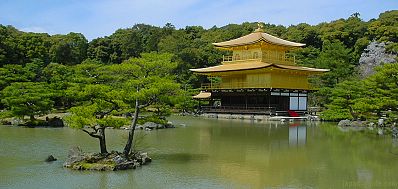
Kyoto was Japan's capital and the emperor's residence from 794 until 1868. It is now the country's seventh largest city with a population of 1.4 million people and a modern face.
Over the centuries, Kyoto was destroyed by many wars and fires, but due to its historic value, the city was not chosen as a target of air raids during World War II. Countless temples, shrines and other historically priceless structures survive in the city today.
Imperial Palace
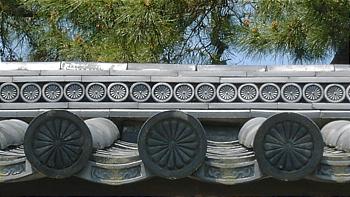
Kyoto Imperial Palace (Kyoto Gosho) used to be the residence of Japan's Imperial Family until 1868, when the emperor and capital were moved from Kyoto to Tokyo. It is located in the spacious Kyoto Imperial Park.
The palace burnt down and was moved around the city several times over the centuries. The present reconstruction dates from 1855. The palace complex is enclosed by a long wall and consists of several gates, halls and gardens. The enthronement ceremonies of Emperors Taisho and Showa were still held in the palace's main hall, but the present Emperor's ceremony took place at the Tokyo Imperial Palace.
The palace can be visited only on guided tours held by the Imperial Household Agency. In order to join a tour, you need to apply for permission in advance with your passport at the agency's office in the Kyoto Imperial Park.
English tours are currently held twice a day on weekdays and on some Saturdays. No tours are held on Sundays and national holidays. Check with the agency for an up to date schedule.
Kyoto Imperial Palace can be reached in about 10 minutes from Kyoto Station by the Karasuma Subway Line. Get off at Marutamachi or Imadegawa Station. Imadegawa Station is closer to the agency's office.
Nijo Castle
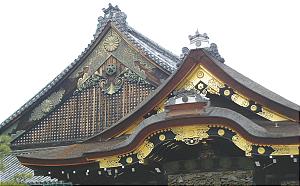
Nijo Castle (Nijojo) was built by Tokugawa Ieyasu, founder of the Edo Shogunate, as the Kyoto residence for himself and his successors.
The palace building now known as Ninomaru ("secondary castle"), was completed in 1603 and enlarged by Ieyasu's grandson Iemitsu. It survives in its original form and is famous for its Momoyama architecture, decorated sliding doors and floors that squeak like nightingales when someone walks on them (a security measure against intruders).
Iemitsu also added the Honmaru ("main castle") including a five storied castle tower to Nijo Castle. However, the original honmaru structures were destroyed by fires in the 18th century, and the present building was moved there from the Imperial Palace in 1893.
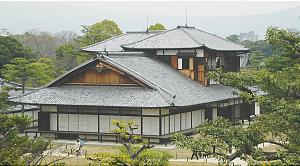
Nijo Castle is most easily accessed from Nijojo-mae Station on the Tozai Subway Line. From Kyoto Station, take the Karasuma Subway Line to Karasuma Oike Station and transfer to the Tozai Line. The whole trip from Kyoto Station takes about 15-20 minutes.
Nijo Jinya
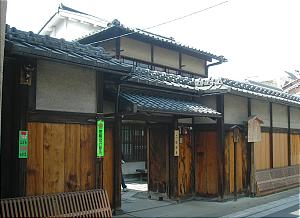
Nijo Jinya is a former inn used by feudal lords (daimyo) who were visiting Kyoto during the Edo Period. In order to guarantee the safety of the important guests, the building has been equipped with secret pathways, trap doors, hidden escape routes and various other security gadgets.
Tours of the intriguing house are held in Japanese only. If you do not understand Japanese, you are asked to bring a Japanese speaking friend or guide for your own and the owner's interest.
Toji
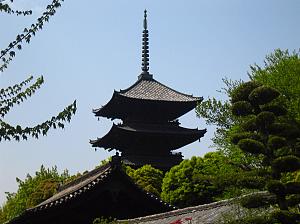
Toji (lit. "Eastern Temple") was founded as the city's guardian temple in the year 794, the same year in which Kyoto became Japan's new capital.
Toji is well known for its five storied pagoda, Japan's tallest with a height of 57 meters, and the Buddhist sculptures that are displayed in the temple's large main hall (kondo) and lecture hall (kodo). Toji is one of Kyoto's many UNESCO world heritage sites.
On the 21st of each month, a lively flea market is held around Toji from the early morning hours until around 16:30 in the afternoon. Various goods including clothes, shoes, tableware, sculptures, foods and plants are on sale.
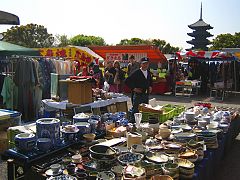 |  |
Unlike most other of Kyoto's attractions, Toji is located south of Kyoto Station. From the station, it can be reached in a 10-15 minute walk.
Honganji
Nishi Honganji and Higashi Honganji are two large temples in the center of Kyoto. As headquarters of the two factions of Jodo Shinshu (True Pure Land Sect), one of Japan's largest Buddhist sects, they are a place to experience a certain atmosphere of contemporary Japanese Buddhism.
Nishi Honganji (West Honganji) was built in 1591 by Toyotomi Hideyoshi, after the former Ishiyama Honganji in Osaka had been destroyed by Oda Nobunaga. Nishi Honganji is the head temple of the Honganji faction of Jodo-Shin Buddhism with over 10,000 subtemples across the country and 200 temples overseas.
Nishi Honganji houses several national treasures, has been designated an UNESCO world heritage site and is considered the more spectacular of the two Honganji temples. However, its main hall is currently being renovated until the end of 2008.
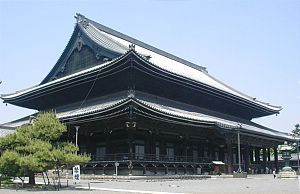
Higashi Honganji (East Honganji) was built only eleven years after and a few steps east of Nishi Honganji as the head temple of the Otani faction. Its main hall is Kyoto's largest wooden structure, but it is currently also being renovated until the year 2011.
The Honganji temples are located a 10 minute walk north of Kyoto Station.
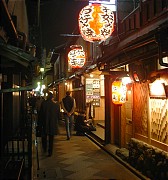
Pontocho
Pontocho is one of Kyoto's traditional nightlife districts where you might be able to spot a geisha apprentice at night. It is a narrow street running from Shijo-dori to Sanjo-dori, one block west of the Kamo River.
In the evenings, the narrow street offers a great atmosphere and lots of restaurants and teahouses, ranging from inexpensive yakitori stores to highly exclusive establishments which require the right connections and a fat wallet.
The closest bus stop to Pontocho is Shijo Kawaramachi, which is served by ten bus lines, including lines 17 and 205 from Kyoto Station. The closest train stations are Kawaramachi Station on the Hankyu Line and Shijo Station on the Keihan Line.
Nishiki Market
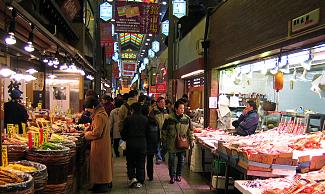
Nishiki Market is a narrow, shopping street, lined by more than one hundred shops. Various kinds of fresh and processed foods including many Kyoto specialties, such as pickles, Japanese sweets, dried food, sushi, and fresh seafood and vegetables are sold.
Known as "Kyoto's Kitchen", Nishiki Market has a history of several centuries, and many stores have been operated by the same families for generations.
Opening hours and closing days depend on each individual store, however, most stores are open between 9:00 and 18:00 and close on one day of the week, typically Wednesday or Sunday.
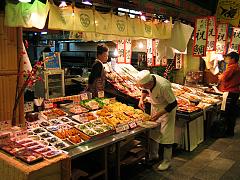 | 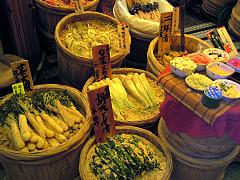 |
The Nishiki Market street runs parallel to Shijo Avenue, one block north of Shijo Avenue. It can be reached on foot in less than 5 minutes from Shijo Station on the Karasuma Subway Line (4 minutes, 200 Yen from Kyoto Station) and Karasuma or Kawaramachi Stations on the Hankyu Line.
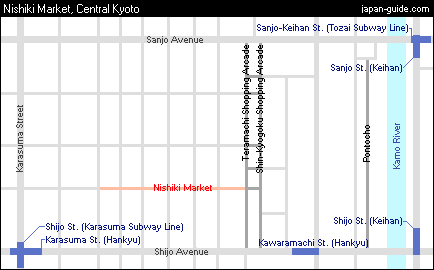
Kyoto Station
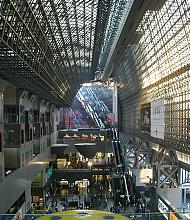 | 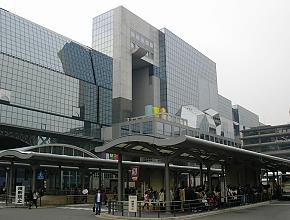 |
The new Kyoto Station building was built on the occasion of the 1,200th anniversary of the Heian Capital foundation. It was opened to the public in 1997 and stands in perfect contrast with many foreign tourists' image of Kyoto as the capital of traditional Japan.
A department store, hotel, theater, game center, shopping mall, government offices, various restaurants and an observation deck can be found on the facility's 15+ floors.